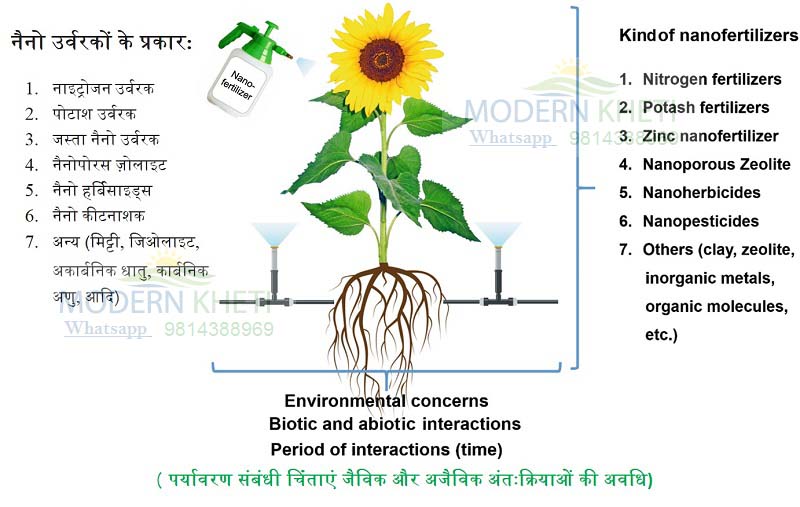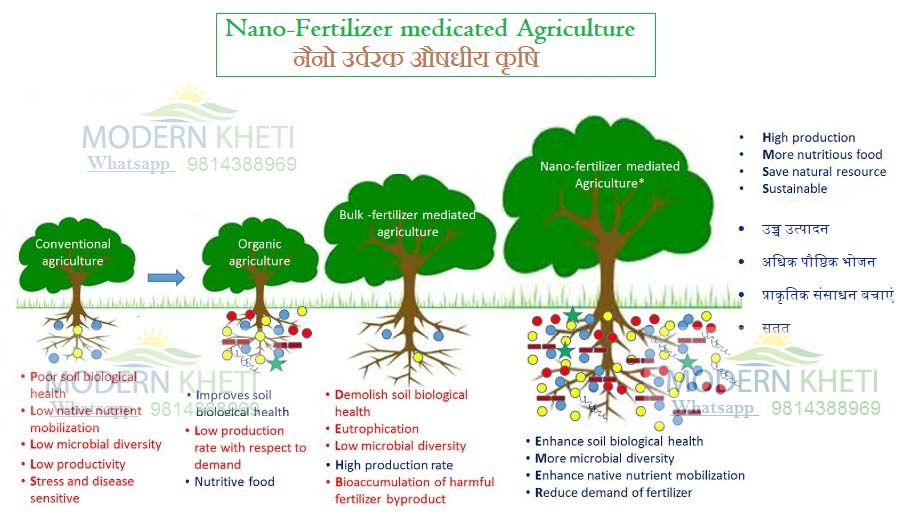Nano Fertilizers नैनो उर्वरक वरदान या अभिशाप best Informative 2023
Nano Fertilizers
Nano Fertilizers

Nano Fertilizers नैनो उर्वरक वरदान या अभिशाप
नैनो-युग 1990’s के दशक के अंत में शुरू हुआ और 2014 तक नैनोकण (Nano Fertilizers नैनो उर्वरक) का प्रयोग पर्यावरण छेत्र के लिए 23 बिलियन डॉलर तक पहुंच गया और अनुमान है कि 2020 तक ये आकंड़ा 42 बिलियन डॉलर तक पहुंच जाएगा।Nano Fertilizers नैनो उर्वरक यद्यपि नैनो शब्द एक नया शब्द प्रतीत होता है लेकिन यह क्षेत्र पूरी तरह से नया नहीं है। जब से धरती पर जीवन का प्रारम्भ हुआ तभी से निरंतर 3.8 अरब वर्षों से विकास के माध्यम से प्रकृति में परिवर्तन हो रहा है।
दुनिया की बढ़ती आबादी को खिलाने के लिए फसल उत्पादन में वृद्धि के लिए नैनो उर्वरक वरदान साबित हो रहे है|
Nano Fertilizers नैनो उर्वरक , आकार में छोटे होने के कारण नैनो उर्वरक मृदा में आसान वितरित हो जाते है और मृदा सुधार में भी मदद करते है। जब हम बात उर्वरक की करते है तो हमे कुछ खास उर्वरको का ही ध्यान आता है जैसे की यूरिया, फॉस्फोरस तथा पोटाश या सल्फर जो की अधातु उर्वरक है| धातु तत्वों जैसे की लोहा (Fe), जस्ता (Zn), तांबा (Cu) आदि को मिलाकर 16 पोषक तत्वों की आवश्यकता होती है। आजकल धातु नैनोकण का प्रयोग उर्वरक के रूप में बहुतायत में किया जा रहा है। जहा हम सामान्य उर्वरक 50 किलो डालते है वही 4-5 किलो नैनो उर्वरक डालने से ज़्यदा उत्पादन लिया जा सकता है।
इसमें कोई संदेह नहीं की नैनोकण के प्रयोग ने मानव जीवन को सरल बनाया है। किन्तु इन कणो का अत्यधिक प्रयोग वातावरण तथा मानव के लिए हानिकारक भी हो सकता है। हाल के आकलन से पता चला है कि नैनो-साइज़ कॉपर और कॉपर-ऑक्साइड के दो सौ से अधिक मीट्रिक टन का उत्पादन 2010 और 5500 टन जिंक नैनो कण का उत्पादन किया गया था। प्रत्येक वर्ष हजारों टन नैनो कण पर्यावरण में छोड़ा जाता है, जिनमें से अधिकांश भाग मृदा में जा कर एकत्र होता हैं।
मृदा अथवा जल में छोड़े गए नैनोकण खाद्य फसलों में एकत्र होते है। डॉ. विष्णु राजपूत द्वारा साउथर्न फेडरल यूनिवर्सिटी, रूस में किये गये शोध में नैनोकण के साथ उगाये गये जौ के पौधो में कॉपर की मात्रा 7 गुना सामान्य पौधो की तुलना में अधिक थी। कई और फसलों पर हुए शोध में भी इस तरह की बात सामने आयी है। छोटा आकर होने के कारण नैनोकण आसानी से मानव शरीर में पानी, हवा एवं ध्य पदार्थो के द्वारा प्रवेश कर जाते है और त्वचा, हृदय, फेफड़े सर्कुलेटरी लिम्फेटिक सिस्टम आदि को प्रभावित तथा कैंसर जैसे बीमारी पैदा कर सकता है।
खाद्य फसलों में नैनो उर्वरक के माध्यम से नैनो कण का संचय अत्यधिक चिंता का विषय है
क्योकि खाद्य फैसले सीधे तौर पर मानव स्वस्थ से जुड़ी है. अतः नैनोपार्टिकल्स का असीमित प्रयोग सोच समझ कर करना होगा।
डॉ. विष्णु राजपूत
(एम. एस. सी. कृषि; पीएचडी; पीडीएफ)
सिनियर रिसर्चर
रूस
USE OF NANO FERTILIZER IS A BOON OR CURSE FOR AGRICULTURE AND HUMANS

Nano Fertilizers नैनो उर्वरक The term nanotechnology was first used in 1974 by Norio Taniguchi. Every particle whose size is 100 nanometers or smaller will be considered as nanoparticles. The chemical and physical characteristics / nature / characteristics of these particles change when they are small. It becomes transparent when zinc nanoparticles are made, etc. The application of nanoparticles has increased tremendously due to specific characteristics, for example, consumer products, agriculture, medical equipment and medicines, cosmetics, chemicals, electronics and optics, environment, food and packing, fuel, energy, textiles and paints, next. Generation of medicine, plastics, nano fertilizer etc. has increased rapidly!
The nano-era began in the late nineties and by 2014 nano particles were used for the environmental sector to reach $ 23 billion and it is estimated that by 2020 the figure will reach $ 42 billion. Although the term Nano seems to be a new term, the field is not entirely new. Ever since life began on Earth, nature has been changing through development for 3.8 billion years continuously.
Nano fertilizers नैनो उर्वरक are proving to be a boon for increasing crop production to feed the world’s growing population.
Being small in size, nano fertilizers are easily distributed in the soil and also help in soil improvement. When we talk about fertilizer, we get attention of certain fertilizers like urea, phosphorus and potash or sulfur which is non-metallic fertilizer. 16 nutrients are required by mixing metal elements such as iron (Fe), zinc (Zn), copper (Cu) etc. Nowadays metal nanoparticles are being used in abundance as fertilizer. Where we add 50 kg of normal fertilizer, the same production can be achieved by adding 4-5 kg of nano fertilizer.
There is no doubt that the use of nanoparticles has simplified human life. But excessive use of these particles can also be harmful to the environment and humans. Recent assessments showed that more than two hundred metric tons of nano-size copper and copper-oxide were produced in 2010 and 5500 tons of zinc nano particles. Every year thousands of tons of nano particles are released into the environment, most of which is collected in the soil. Nano particles released in soil or water collect in food crops. In research done by Dr. Vishnu Rajput at Russia, the amount of copper in barley plants grown with nano particles was 7 times more than that of normal plants. Research on many more crops has also revealed this type of thing. Due to its small size, nano particles easily enter the human body through water, air and food substances and can affect the skin, heart, lung circulatory lymphatic system etc. and cause diseases like cancer.
Nano Fertilizers नैनो उर्वरक
Accumulation of nano particles through nano fertilizer in food crops is a matter of great concern as food decisions are directly related to human health.
Therefore, unlimited use of nano particles has to be done with careful consideration.
Dr. Vishnu Rajput
(M.Sc. Agriculture; PhD:PDF)
Senior researcher
Russia
Diseases of paddy and management ||धान के प्रमुख रोग और उनका प्रबंधन 2022 New


Comments are closed.